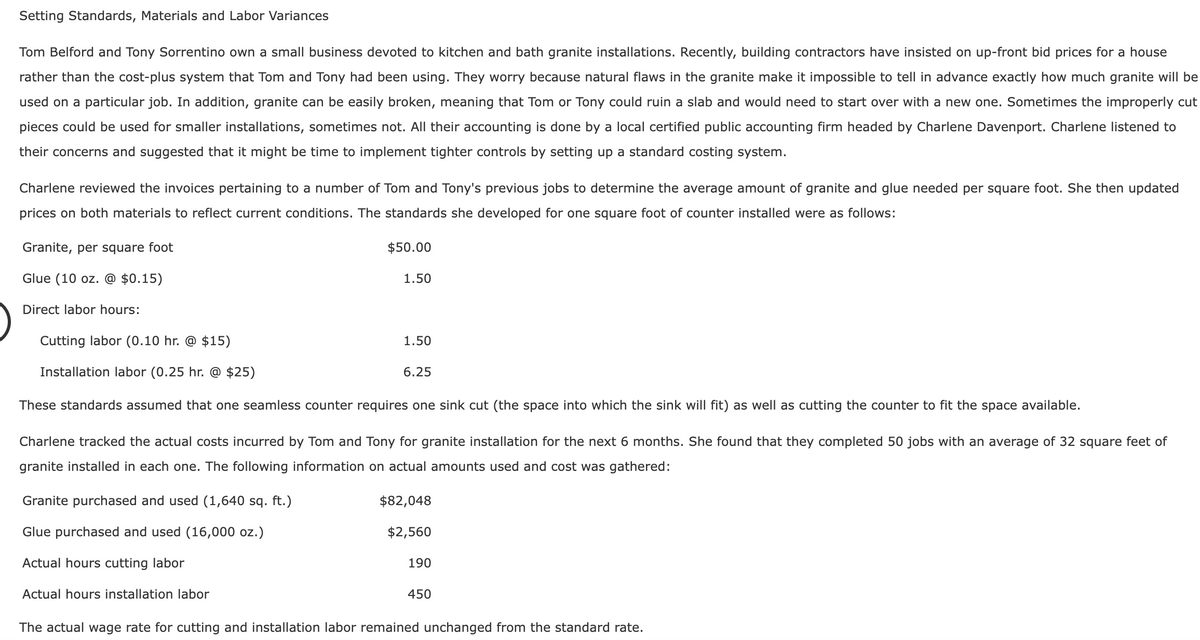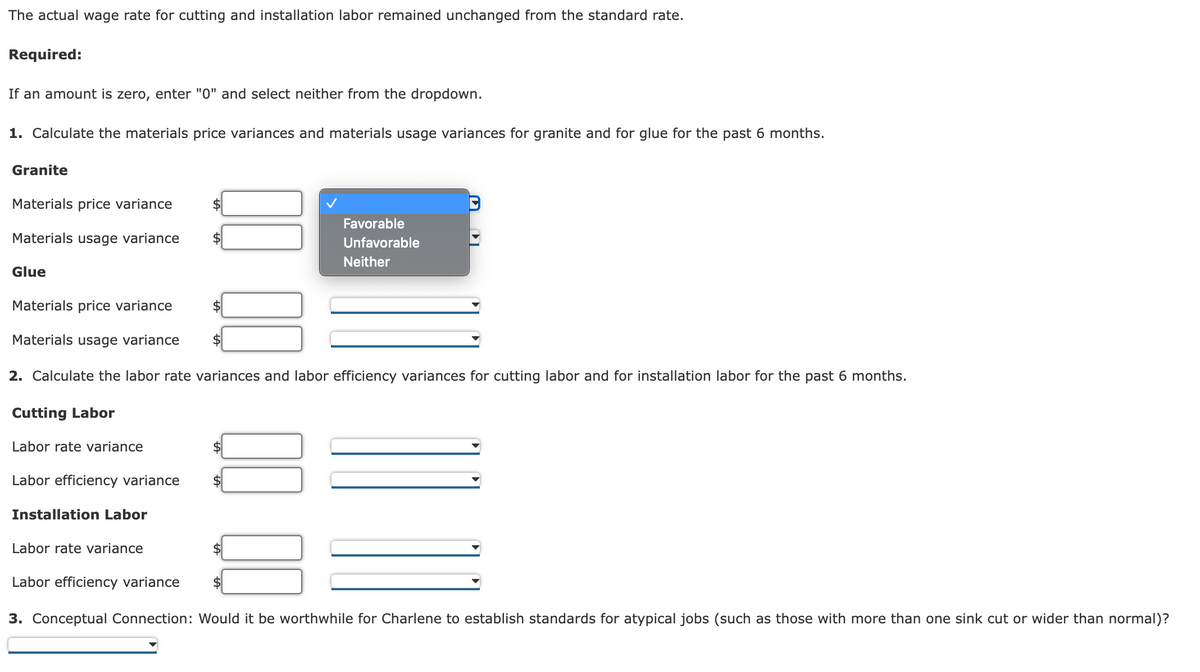Setting Standards, Materials and Labor Variances Tom Belford and Tony Sorrentino own a small business devoted to kitchen and bath granite installations. Recently, building contractors have insisted on up-front bid prices for a house rather than the cost-plus system that Tom and Tony had been using. They worry because natural flaws in the granite make it impossible to tell in advance exactly how much granite will b used on a particular job. In addition, granite can be easily broken, meaning that Tom or Tony could ruin a slab and would need to start over with a new one. Sometimes the improperly cu pieces could be used for smaller installations, sometimes not. All their accounting is done by a local certified public accounting firm headed by Charlene Davenport. Charlene listened to their concerns and suggested that it might be time to implement tighter controls by setting up a standard costing system. Charlene reviewed the invoices pertaining to a number of Tom and Tony's previous jobs to determine the average amount of granite and glue needed per square foot. She then updated prices on both materials to reflect current conditions. The standards she developed for one square foot of counter installed were as follows: Granite, per square foot $50.00 Glue (10 oz. @ $0.15) 1.50 Direct labor hours: Cutting labor (0.10 hr. @ $15) 1.50 Installation labor (0.25 hr. @ $25) 6.25 These standards assumed that one seamless counter requires one sink cut (the space into which the sink will fit) as well as cutting the counter to fit the space available. Charlene tracked the actual costs incurred by Tom and Tony for granite installation for the next 6 months. She found that they completed 50 jobs with an average of 32 square feet of granite installed in each one. The following information on actual amounts used and cost was gathered: Granite purchased and used (1,640 sq. ft.) $82,048 Glue purchased and used (16,000 oz.) $2,560 Actual hours cutting labor 190 Actual hours installation labor 450 The actual wage rate for cutting and installation labor remained unchanged from the standard rate.
Setting Standards, Materials and Labor Variances Tom Belford and Tony Sorrentino own a small business devoted to kitchen and bath granite installations. Recently, building contractors have insisted on up-front bid prices for a house rather than the cost-plus system that Tom and Tony had been using. They worry because natural flaws in the granite make it impossible to tell in advance exactly how much granite will b used on a particular job. In addition, granite can be easily broken, meaning that Tom or Tony could ruin a slab and would need to start over with a new one. Sometimes the improperly cu pieces could be used for smaller installations, sometimes not. All their accounting is done by a local certified public accounting firm headed by Charlene Davenport. Charlene listened to their concerns and suggested that it might be time to implement tighter controls by setting up a standard costing system. Charlene reviewed the invoices pertaining to a number of Tom and Tony's previous jobs to determine the average amount of granite and glue needed per square foot. She then updated prices on both materials to reflect current conditions. The standards she developed for one square foot of counter installed were as follows: Granite, per square foot $50.00 Glue (10 oz. @ $0.15) 1.50 Direct labor hours: Cutting labor (0.10 hr. @ $15) 1.50 Installation labor (0.25 hr. @ $25) 6.25 These standards assumed that one seamless counter requires one sink cut (the space into which the sink will fit) as well as cutting the counter to fit the space available. Charlene tracked the actual costs incurred by Tom and Tony for granite installation for the next 6 months. She found that they completed 50 jobs with an average of 32 square feet of granite installed in each one. The following information on actual amounts used and cost was gathered: Granite purchased and used (1,640 sq. ft.) $82,048 Glue purchased and used (16,000 oz.) $2,560 Actual hours cutting labor 190 Actual hours installation labor 450 The actual wage rate for cutting and installation labor remained unchanged from the standard rate.
Principles of Cost Accounting
17th Edition
ISBN:9781305087408
Author:Edward J. Vanderbeck, Maria R. Mitchell
Publisher:Edward J. Vanderbeck, Maria R. Mitchell
Chapter8: Standard Cost Accounting—materials, Labor, And Factory Overhead
Section: Chapter Questions
Problem 1P: Materials and labor variances Branca Inspections Inc. specializes in determining whether a building...
Related questions
Concept explainers
Variance Analysis
In layman's terms, variance analysis is an analysis of a difference between planned and actual behavior. Variance analysis is mainly used by the companies to maintain a control over a business. After analyzing differences, companies find the reasons for the variance so that the necessary steps should be taken to correct that variance.
Standard Costing
The standard cost system is the expected cost per unit product manufactured and it helps in estimating the deviations and controlling them as well as fixing the selling price of the product. For example, it helps to plan the cost for the coming year on the various expenses.
Topic Video
Question

Transcribed Image Text:Setting Standards, Materials and Labor Variances
Tom Belford and Tony Sorrentino own a small business devoted to kitchen and bath granite installations. Recently, building contractors have insisted on up-front bid prices for a house
rather than the cost-plus system that Tom and Tony had been using. They worry because natural flaws in the granite make it impossible to tell in advance exactly how much granite will be
used on a particular job. In addition, granite can be easily broken, meaning that Tom or Tony could ruin a slab and would need to start over with a new one. Sometimes the improperly cut
pieces could be used for smaller installations, sometimes not. All their accounting is done by a local certified public accounting firm headed by Charlene Davenport. Charlene listened to
their concerns and suggested that it might be time to implement tighter controls by setting up a standard costing system.
Charlene reviewed the invoices pertaining to a number of Tom and Tony's previous jobs to determine the average amount of granite and glue needed per square foot. She then updated
prices on both materials to reflect current conditions. The standards she developed for one square foot of counter installed were as follows:
Granite, per square foot
$50.00
Glue (10 oz. @ $0.15)
1.50
Direct labor hours:
Cutting labor (0.10 hr. @ $15)
1.50
Installation labor (0.25 hr. @ $25)
6.25
These standards assumed that one seamless counter requires one sink cut (the space into which the sink will fit) as well as cutting the counter to fit the space available.
Charlene tracked the actual costs incurred by Tom and Tony for granite installation for the next 6 months. She found that they completed 50 jobs with an average of 32 square feet of
granite installed in each one. The following information on actual amounts used and cost was gathered:
Granite purchased and used (1,640 sq. ft.)
$82,048
Glue purchased and used (16,000 oz.)
$2,560
Actual hours cutting labor
190
Actual hours installation labor
450
The actual wage rate for cutting and installation labor remained unchanged from the standard rate.

Transcribed Image Text:The actual wage rate for cutting and installation labor remained unchanged from the standard rate.
Required:
If an amount is zero, enter "0" and select neither from the dropdown.
1. Calculate the materials price variances and materials usage variances for granite and for glue for the past 6 months.
Granite
Materials price variance
Favorable
Materials usage variance
$
Unfavorable
Neither
Glue
Materials price variance
Materials usage variance
2. Calculate the labor rate variances and labor efficiency variances for cutting labor and for installation labor for the past 6 months.
Cutting Labor
Labor rate variance
Labor efficiency variance
Installation Labor
Labor rate variance
Labor efficiency variance
2$
3. Conceptual Connection: Would it be worthwhile for Charlene to establish standards for atypical jobs (such as those with more than one sink cut or wider than normal)?
Expert Solution
This question has been solved!
Explore an expertly crafted, step-by-step solution for a thorough understanding of key concepts.
This is a popular solution!
Trending now
This is a popular solution!
Step by step
Solved in 2 steps with 4 images

Knowledge Booster
Learn more about
Need a deep-dive on the concept behind this application? Look no further. Learn more about this topic, accounting and related others by exploring similar questions and additional content below.Recommended textbooks for you

Principles of Cost Accounting
Accounting
ISBN:
9781305087408
Author:
Edward J. Vanderbeck, Maria R. Mitchell
Publisher:
Cengage Learning

Managerial Accounting: The Cornerstone of Busines…
Accounting
ISBN:
9781337115773
Author:
Maryanne M. Mowen, Don R. Hansen, Dan L. Heitger
Publisher:
Cengage Learning

Principles of Accounting Volume 2
Accounting
ISBN:
9781947172609
Author:
OpenStax
Publisher:
OpenStax College

Principles of Cost Accounting
Accounting
ISBN:
9781305087408
Author:
Edward J. Vanderbeck, Maria R. Mitchell
Publisher:
Cengage Learning

Managerial Accounting: The Cornerstone of Busines…
Accounting
ISBN:
9781337115773
Author:
Maryanne M. Mowen, Don R. Hansen, Dan L. Heitger
Publisher:
Cengage Learning

Principles of Accounting Volume 2
Accounting
ISBN:
9781947172609
Author:
OpenStax
Publisher:
OpenStax College